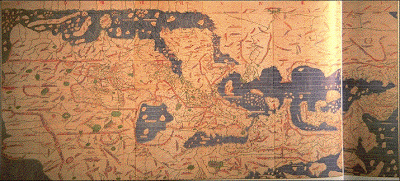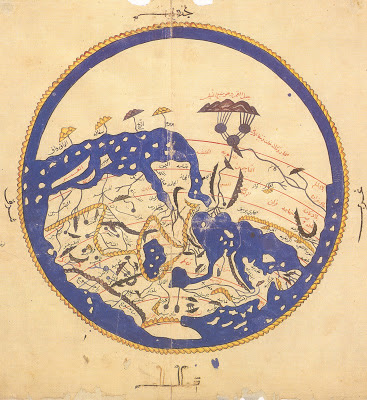பதினொன்றாம் நூற்றாண்டு உலக வரைபடம்:

பதினொன்றாம் நூற்றாண்டு உலக வரைபடம். ஒரு வித்தியாசமான உலக வரைபடம், இதில் இந்தியா, ஆப்ரிக்கா, அரேபியா, ஐரோப்பா போன்ற நாடுகளின் அமைவிடங்களை காணலாம். நவீன உலக வரைபடங்களை பார்த்த நமக்கு இந்த வரைபடம் சற்று நகைச்சுவையாக தான் தெரியும்.

துருக்கியர்களால் பதினொன்றாம் நூற்றாண்டில் வரையப்பட்ட உலக வரைபடம் உலகம் கடலால் சூழப்பட்டுள்ளது போன்று இது வரையப்பட்டிருகிறது


Isidorean mappamundi,11th century

Y-O map, from Macrobius' Commentarium in somnium, 11th century.
T-O map, from 11th century MS. edition of Beatus' Commentary

St. Sever world map after Beatus, 1030 A.D.

al-Biruni world map of the distribution of land and sea, 1029 A.D.

Ibn al-Wardi world map, 1001 A.D.
பன்னிரெண்டாம் நூற்றாண்டு உலக வரைபடம்:


_1190+-+Kopie+%282%29.PNG)

இத்தாலியர்களால் பன்னிரண்டாம் நூற்றாண்டில் வரையப்பட்ட உலக வரைபடம்

Abu Abd Allah Muhammad al-Idrisi என்னும் அரபியரால் கி பி 1154 ஆம் ஆண்டு வரையப்பட்ட உலக வரைபடம்

Macrobian World Map from a French MS, 12th century

Map of Jerusalem, 12th century

Beatus world map, London copy, 1109 A.D.


Beatus world map, Turin copy, 1150 A. D.

Beatus world map, Altamira copy, 12 th century.
(oriented with East at the top)

zonal world map, Lambert of St. Omer, Martianus Capella,Ghent copy,1120 A.D.














